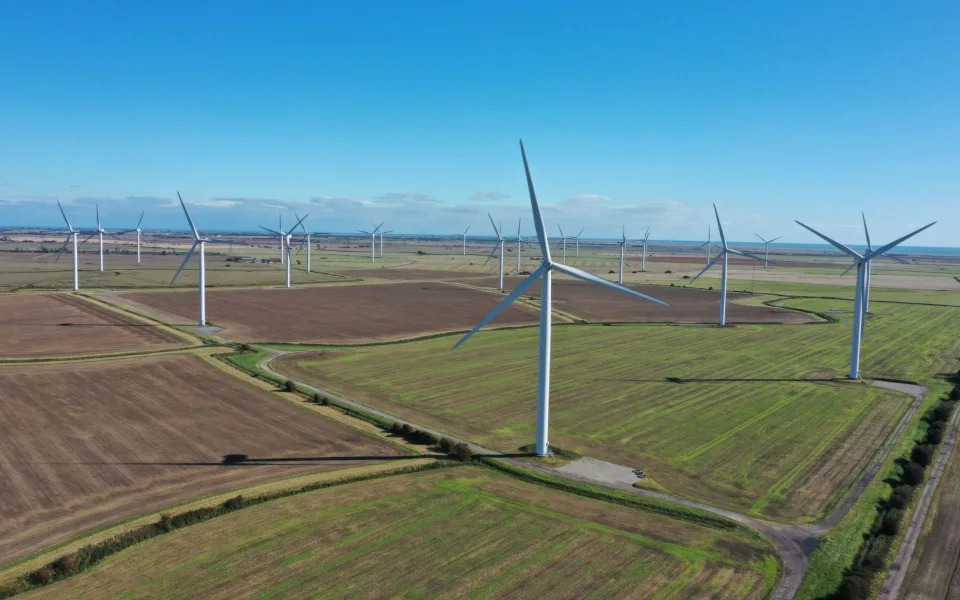UK
Manchester plans world’s largest battery to tackle intermittent wind energyHoward Mustoe
THE TELEGRAPH
Mon, 24 July 2023

Scotland's first ever commercial windfarm
Blueprints for the world’s largest battery on the site of an old coal-fired power station in Manchester, storing enough energy for 36,000 homes for a week, have won approval from planning officials.
Carlton Power, an independent energy company, will need to raise £750m for the plant and is “advanced talks” to raise the funds, it said. It will then need to pick a supplier.
Battery plants are seen as a way to smooth out power demand as more electricity comes from intermittent sources like wind and solar.
Batteries can charge on windy or sunny days cheaply, or even for free, and then deploy that power when needed. The plant is expected to offer the equivalent of 2,080 megawatts – a decent sized power station – for an hour.
Planning permission was granted by Trafford Council. Carlton has also won approval for a green hydrogen project in the area.
Councillor Tom Ross, the leader of Trafford Council, said: “The Trafford battery energy storage scheme, alongside the Trafford Green Hydrogen scheme, places Trafford and Greater Manchester at the forefront of the UK’s energy transition. The two schemes will help address our climate crisis – one of Trafford Council’s corporate priorities - and will support our region’s plan to reach a target of net zero carbon emissions by 2038.”
It will be built at the Trafford Low Carbon Energy Park in Greater Manchester, which will also host the world’s first commercial liquid air storage system, being built by Highview Power, another energy storage firm, using its cryobattery technology.
The pioneering technology works by compressing air into a liquid and then cooling it to almost minus 200°C. The liquid air is stored in an insulated tank at low pressure, which functions as the energy store. When power is needed, liquid air is drawn from the tank and pumped to high pressure.
Stored heat from the air liquefier is applied to the liquid air via heat exchangers and an intermediate heat transfer fluid. This produces a high pressure gas, which is then used to drive a turbine and generate electricity.
The technology competes with pumped-storage hydroelectricity, which uses excess power to pump water uphill, releasing it through turbines to generate electricity.
It takes a few minutes for a liquid air station to start generating power, which is where batteries can fill the gap.
Chris McKerro of Carlton Power said: “Our battery energy storage scheme will make a significant contribution to the resilience of the North West’s energy system and, combined with our green hydrogen scheme and the cryobattery project, underlines Trafford Park’s importance to the energy transition in the region and the journey towards Net Zero.”
Mon, 24 July 2023

Scotland's first ever commercial windfarm
Blueprints for the world’s largest battery on the site of an old coal-fired power station in Manchester, storing enough energy for 36,000 homes for a week, have won approval from planning officials.
Carlton Power, an independent energy company, will need to raise £750m for the plant and is “advanced talks” to raise the funds, it said. It will then need to pick a supplier.
Battery plants are seen as a way to smooth out power demand as more electricity comes from intermittent sources like wind and solar.
Batteries can charge on windy or sunny days cheaply, or even for free, and then deploy that power when needed. The plant is expected to offer the equivalent of 2,080 megawatts – a decent sized power station – for an hour.
Planning permission was granted by Trafford Council. Carlton has also won approval for a green hydrogen project in the area.
Councillor Tom Ross, the leader of Trafford Council, said: “The Trafford battery energy storage scheme, alongside the Trafford Green Hydrogen scheme, places Trafford and Greater Manchester at the forefront of the UK’s energy transition. The two schemes will help address our climate crisis – one of Trafford Council’s corporate priorities - and will support our region’s plan to reach a target of net zero carbon emissions by 2038.”
It will be built at the Trafford Low Carbon Energy Park in Greater Manchester, which will also host the world’s first commercial liquid air storage system, being built by Highview Power, another energy storage firm, using its cryobattery technology.
The pioneering technology works by compressing air into a liquid and then cooling it to almost minus 200°C. The liquid air is stored in an insulated tank at low pressure, which functions as the energy store. When power is needed, liquid air is drawn from the tank and pumped to high pressure.
Stored heat from the air liquefier is applied to the liquid air via heat exchangers and an intermediate heat transfer fluid. This produces a high pressure gas, which is then used to drive a turbine and generate electricity.
The technology competes with pumped-storage hydroelectricity, which uses excess power to pump water uphill, releasing it through turbines to generate electricity.
It takes a few minutes for a liquid air station to start generating power, which is where batteries can fill the gap.
Chris McKerro of Carlton Power said: “Our battery energy storage scheme will make a significant contribution to the resilience of the North West’s energy system and, combined with our green hydrogen scheme and the cryobattery project, underlines Trafford Park’s importance to the energy transition in the region and the journey towards Net Zero.”
No comments:
Post a Comment